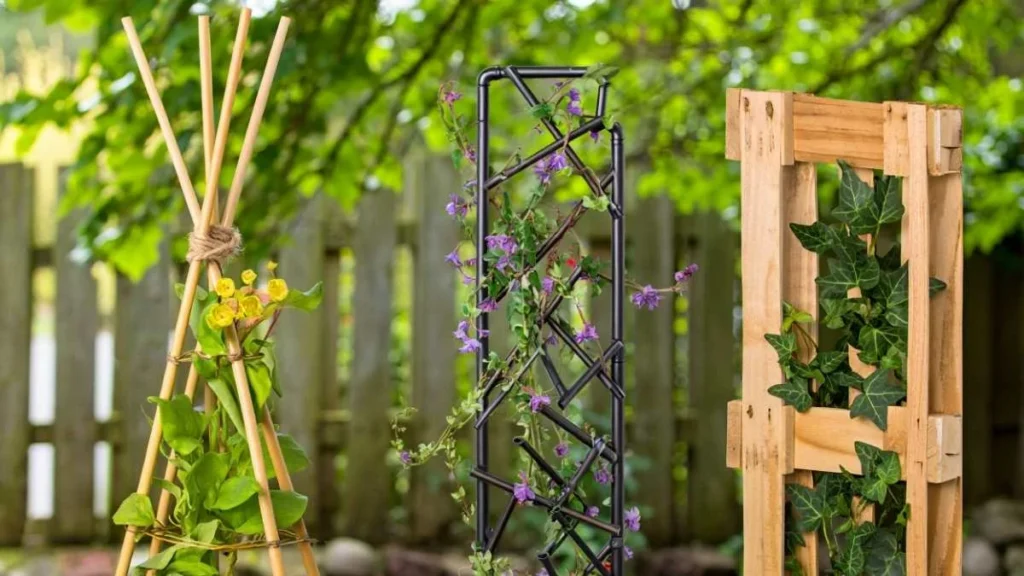A DIY garden trellis is a simple yet transformative addition that enhances both the functionality and charm of any outdoor space. It’s a handmade structure that supports climbing plants, saves ground space, and brings visual appeal to gardens, patios, or balconies.
- Why Make Your Own Garden Trellis
- Common Materials Used in Garden Trellis Building
- Different Types of Garden Trellis Designs
- Step-by-Step: Building a Simple Wooden DIY Garden Trellis
- Innovative and Eco-Friendly Trellis Ideas
- Matching Plants with the Right Trellis Style
- Environmental Role
- Safety and Longevity Tips
- FAQs
- Conclusion
What is a DIY garden trellis? It’s a self-built plant support framework made from wood, metal, bamboo, or recycled materials to guide vines and vegetables upward. This not only optimizes limited space but also improves airflow, reduces plant disease, and gives your garden an artistic touch. Whether you’re growing beans, roses, or cucumbers, a trellis helps create a beautiful, thriving, and organized green haven.
Why Make Your Own Garden Trellis
Building your own DIY garden trellis offers multiple rewards that go beyond cost savings; it’s a creative, eco-friendly, and deeply personal way to enhance your garden. Making it yourself lets you customize the design, shape, and height to match your plants and space perfectly, whether it’s a small balcony or a spacious backyard. It’s also a sustainable choice since you can repurpose old wood, wire, or bamboo instead of purchasing new materials, reducing waste and environmental impact.

Common Materials Used in Garden Trellis Building
Choose options that suit your local climate and garden layout.
| Material | Advantages | Best Suited For |
| Wood | Natural, customizable, and classic look | Vegetable patches and floral beds |
| Bamboo | Lightweight and eco-friendly | Vertical gardens, small balconies |
| Metal | Strong and weather-resistant | Heavy vines like wisteria or grapes |
| PVC Pipe | Low-cost and flexible | Temporary setups and urban gardens |
| Wire Mesh | Simple and minimalistic | Peas, cucumbers, beans |
| Recycled Items | Sustainable and creative | Rustic or reclaimed-style gardens |
Different Types of Garden Trellis Designs
Trellises come in all shapes and configurations, each offering unique benefits for plant growth and visual appeal.
1. Flat Panel or Wall Trellis
Ideal for small gardens or patios. Attach to fences or walls using hooks or screws. Great for jasmine, ivy, or climbing roses.
2. A-Frame Trellis
Shaped like a folding ladder, this design provides dual-sided support, perfect for vegetables like peas and beans.
3. Obelisk Trellis
A tall, pyramid-like structure that adds elegance to pots or flower beds. Excellent for ornamental vines.
4. Archway Trellis
A decorative garden element for entrances or pathways. Works beautifully for passionflowers or morning glories.
Step-by-Step: Building a Simple Wooden DIY Garden Trellis
Follow this easy guide for a durable structure that blends form and function.
Materials Needed
- 4–6 wooden slats (1×2 or 2×2 inches)
- Screws or nails
- Measuring tape
- Drill or hammer
- Weatherproof wood finish
- Optional: garden wire or brackets
Instructions
- Measure and Plan: Decide on the height (typically 5–6 ft). Sketch your layout for precision.
- Cut and Arrange: Lay two vertical slats on the ground. Place horizontal slats 6–8 inches apart.
- Secure the Structure: Fasten using screws or nails. Ensure equal spacing for balanced plant growth.
- Seal and Finish: Apply a protective finish to withstand outdoor conditions.
- Install the Trellis: Anchor it into the soil or fix it to a fence for stability.
Innovative and Eco-Friendly Trellis Ideas
Creative and sustainable DIY garden trellis designs can elevate any outdoor space. Repurpose old pallets for a rustic herb wall, or build a bamboo teepee tied with jute for a natural look. Urban gardeners can use string or wire grids for compact vertical setups, while metal pipe frames suit modern styles. For added charm, wrap fairy lights around an arch trellis to create a cozy evening ambiance. Each of these eco-friendly garden ideas combines beauty, functionality, and sustainability in perfect balance.
Matching Plants with the Right Trellis Style
Selecting suitable plants ensures successful climbing and optimal aesthetics.
| Trellis Type | Recommended Plants |
| Flat Panel | Clematis, Jasmine, Ivy |
| A-Frame | Beans, Cucumbers, Peas |
| Obelisk | Sweet Peas, Morning Glory |
| Wire Grid | Tomatoes, Melons |
| Archway | Honeysuckle, Wisteria |
Environmental Role
A well-built DIY garden trellis not only supports plant growth but also enhances your garden’s health and appearance. It encourages better air circulation, keeps foliage off damp soil to prevent disease, and maximizes limited space in small gardens or balconies. Beyond functionality, trellises add vertical beauty, texture, and dimension to landscapes while attracting pollinators like bees and butterflies. This blend of sustainability, organization, and aesthetic charm makes a trellis a valuable feature for any modern, eco-friendly garden.
Safety and Longevity Tips
A well-built trellis not only looks good but also stays safe for long-term use.
- Avoid placing too close to walls with poor drainage.
- Use rust-proof screws and joints.
- Ensure stability before planting heavy vines.
- Treat materials to resist moisture and UV damage.

Taking preventive steps ensures your climbing plant frame stands strong season after season.
FAQs
Q1: What is the ideal height for a garden trellis?
A: Most climbers thrive on trellises between 5 and 7 feet tall.
Q2: Can I use recycled metal or plastic for trellis building?
A: Yes, as long as the material is rust-free and sturdy.
Q3: How often should a wooden trellis be resealed?
A: Every 1–2 years, depending on exposure to moisture and sunlight.
Conclusion
A DIY garden trellis is more than just a structure; it’s a symbol of creativity, sustainability, and personal achievement. By blending recycled materials, simple designs, and thoughtful plant choices, you can create a stunning feature that enhances both productivity and aesthetics.
Whether you build a modest bamboo frame or an elegant wooden arch, your handmade trellis supports growth in your plants and in your gardening passion. Start today, and watch your garden flourish.






